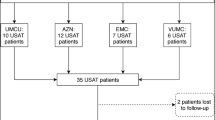Abstract
Pulmonary embolism (PE) is a significant contributor to morbidity and mortality in the United States. Catheter-directed, ultrasound-assisted thrombolysis (USAT) uses high-frequency, low-energy ultrasound waves to disaggregate uncrosslinked fibrin fibers and increase thrombus penetration of a locally delivered thrombolytic to treat an acute PE. The purpose of this study is to compare the efficacy and safety of catheter-directed USAT versus systemic anticoagulation alone in submassive PE. This was a single-center, retrospective study of patients with a diagnosis of acute submassive PE from April 4, 2014 to May 1, 2019 at a large, academic medical center. Subjects were split into two different groups based on treatment with either USAT with systemic anticoagulation or systemic anticoagulation alone. The primary outcome was the incidence of severe or life-threatening GUSTO bleeding within 72 h or until hospital discharge if sooner. A total of 130 subjects were included (n = 40 in the USAT group and n = 90 in systemic anticoagulation alone group). Significantly fewer subjects in the USAT group had an active diagnosis of cancer at the time of presentation (7.5% vs 28.9%, p = 0.006). There was no difference in severe or life-threatening GUSTO bleeding or any component of the GUSTO bleeding definitions. Administration of USAT with systemic anticoagulation was well-tolerated when compared to systemic anticoagulation alone, but bias may have led to selection of patients for USAT with a lower bleeding risk and higher functional status at baseline.



Similar content being viewed by others
Data availability
Data will not be deposited.
References
White RH (2003) The epidemiology of venous thromboembolism. Circulation 107(23 Suppl 1):I4–8
Lloyd-Jones D, Adams RJ, Brown TM et al (2010) Heart disease and stroke statistics–2010 update: a report from the american heart association. Circulation 121(7):e46–e215
Heit JA, Cohen AT, Anderson FA (2005) Estimated annual number of incident and recurrent, non-fatal and fatal venous thromboembolism (VTE) events in the U.S. Blood 106(11):910
Goldhaber SZ, Visani L, De rosa M. (1999) Acute pulmonary embolism: clinical outcomes in the international cooperative pulmonary embolism registry (ICOPER). Lancet 353(9162):1386–1389
Konstantinides SV, Meyer G, Becattini C et al (2020) 2019 ESC Guidelines for the diagnosis and management of acute pulmonary embolism developed in collaboration with the european respiratory society (ERS). Eur Heart J 41:543–603
Jaff MR, McMurtry S, Archer SL et al (2011) Management of massive and submassive pulmonary embolism, iliofemoral deep vein thrombosis, and chronic thromboembolic pulmonary hypertension. Circulation 123:1788–2183
Kearon C, Akl EA, Ornelas J et al (2016) Antithrombotic therapy for VTE Disease: cHEST guideline and expert panel report. Chest 149(2):315–352
Engelberger RP, Kucher N (2011) Catheter-based reperfusion treatment of pulmonary embolism. Circulation 124(19):2139–2144
Engelberger RP, Kucher N (2014) Ultrasound-assisted thrombolysis for acute pulmonary embolism: a systematic review. Eur Heart J 35(12):758–764
Kucher N, Boekstegers P, Müller OJ et al (2014) Randomized, controlled trial of ultrasound-assisted catheter-directed thrombolysis for acute intermediate-risk pulmonary embolism. Circulation 129(4):479–486
Piazza G, Hohlfelder B, Jaff MR et al (2015) A prospective, single-arm, multicenter trial of ultrasound-facilitated, catheter-directed, low-dose fibrinolysis for acute massive and Submassive pulmonary embolism: the SEATTLE II study. JACCCardiovascInterv 8(10):1382–1392
Tapson VF, Sterling K, Jones N et al (2018) A randomized trial of the optimum duration of acoustic pulse thrombolysis procedure in acute intermediate-risk pulmonary embolism: the OPTALYSE PE trial. JACCCardiovascInterv 11(14):1401–1410
Kuo WT, Banerjee A, Kim PS et al (2015) Pulmonary embolism response to fragmentation, embolectomy, and catheter thrombolysis (PERFECT): initial results from a prospective multicenter registry. Chest 148(3):667–673
Wayne NB, Davis GA, Macaulay TE et al (2020) Reduced dose thrombolysis with ultrasound-facilitated catheter-directed administration for acute pulmonary embolism reduces length of stay. J ThrombThrombolysis 49(4):540–544
Bloomer TL, El-hayek GE, Mcdaniel MC et al (2017) Safety of catheter-directed thrombolysis for massive and submassive pulmonary embolism: Results of a multicenter registry and meta-analysis. Catheter CardiovascInterv 89(4):754–760
Pillus D, Bruno E, Farcy D, Vilke GM, Childers R (2019) Systematic review: the role of thrombolysis in intermediate-risk pulmonary embolism. J Emerg Med 57(4):517–522
Mehran R, Rao SV, Bhatt DL et al (2011) Standardized bleeding definitions for cardiovascular clinical trials: a consensus report from the bleeding academic research consortium. Circulation 123(23):2736–2747
Funding
Not applicable.
Author information
Authors and Affiliations
Contributions
All authors made substantial contributions to the design and interpretation of the work, drafted or critically revised the manuscript for important intellectual content, and approve of the version to be published.
Corresponding author
Ethics declarations
Conflicts of interest
None of the authors have any financial or personal conflicts of interest to disclose.
Ethics approval
This study was reviewed and approved by the institution’s local institutional review board (IRB).
Informed consent
The study was granted a waiver of informed consent and Health Insurance Portability and Accountability Act (HIPAA) authorization by the IRB given the retrospective nature of the study with minimal risk to subjects.
Additional information
Publisher's Note
Springer Nature remains neutral with regard to jurisdictional claims in published maps and institutional affiliations.
Rights and permissions
About this article
Cite this article
Kline, T.M., Rodino, A.M., Dorszynski, A. et al. Ultrasound-assisted catheter-directed thrombolysis versus systemic anticoagulation alone for submassive pulmonary embolism. J Thromb Thrombolysis 52, 130–137 (2021). https://doi.org/10.1007/s11239-020-02278-2
Accepted:
Published:
Issue Date:
DOI: https://doi.org/10.1007/s11239-020-02278-2




